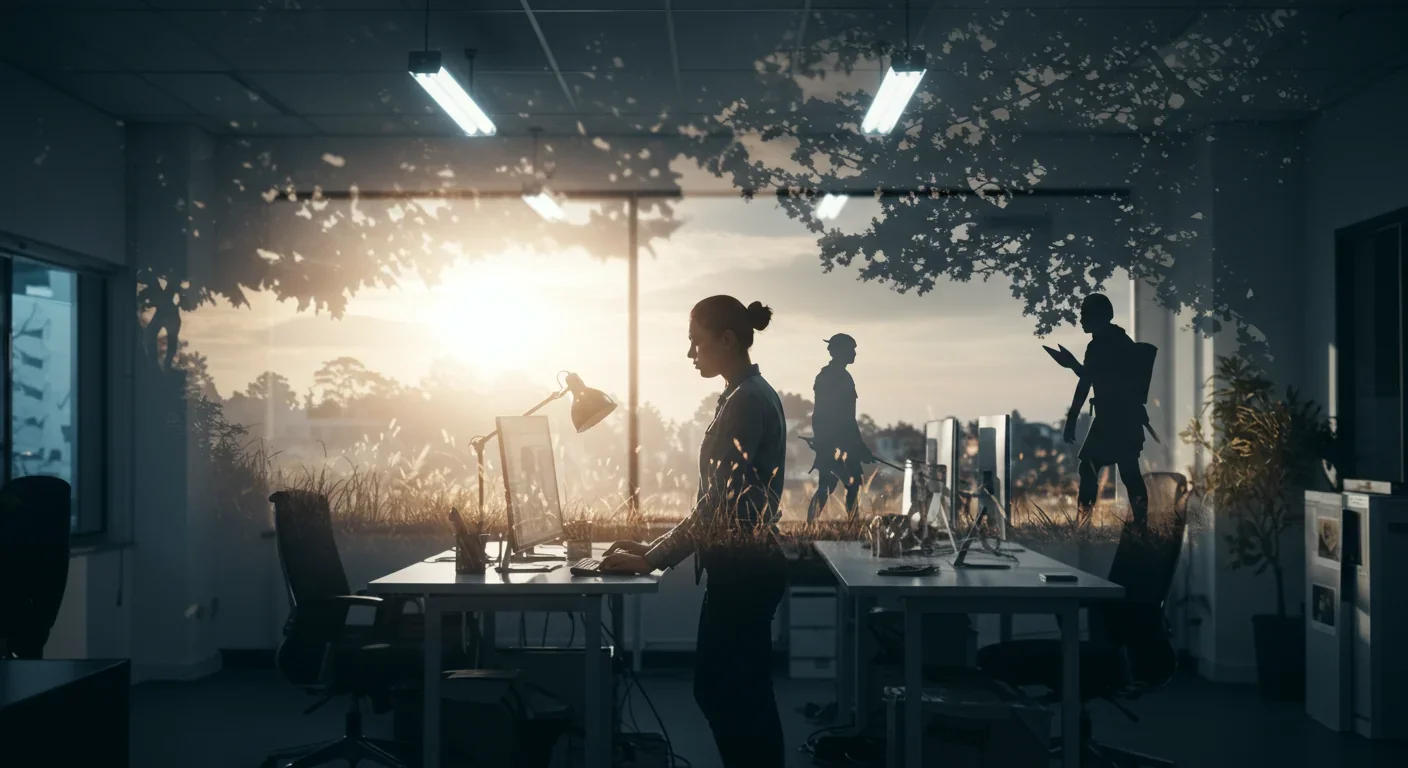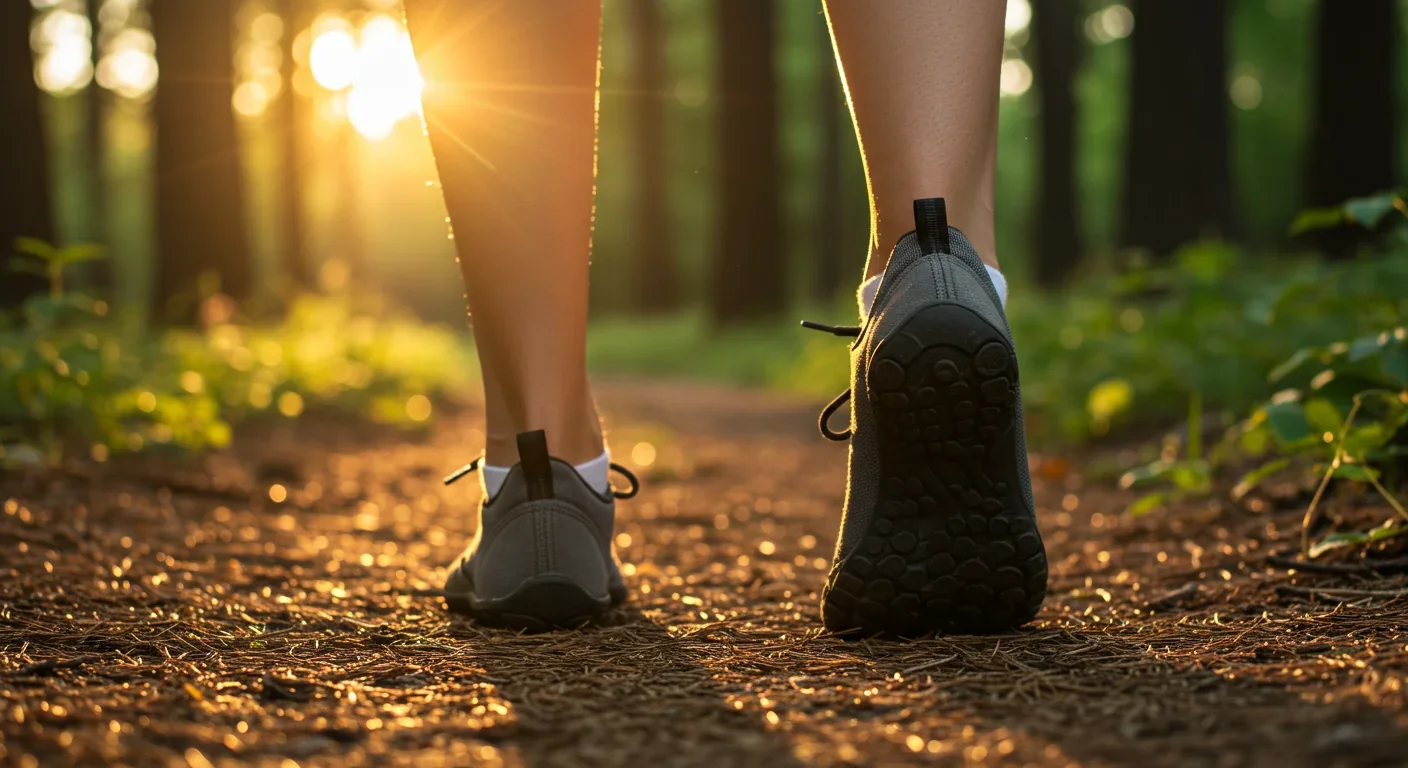Why Your Brain Sees Gods and Ghosts in Random Events

TL;DR: Your biology evolved for life 10,000 years ago, but you're living in 2025. This evolutionary mismatch drives obesity, depression, sleep disorders, and chronic disease as ancient survival mechanisms backfire in modern environments.

Your alarm jolts you awake at 6 AM. You grab your phone, scroll through notifications while the coffee brews, sit in traffic for an hour, then spend eight hours under fluorescent lights staring at screens. By evening, you're exhausted but wired, so you binge a series until midnight. Your body, meanwhile, is confused as hell. It thinks you're still a hunter-gatherer on the African savanna, and this modern life you're living? It has absolutely no idea what to do with it.
This disconnect between our ancient biology and contemporary environment has a name: evolutionary mismatch. And it's quietly wreaking havoc on your health in ways you probably never connected.
Here's the thing about evolution: it's spectacularly slow. Our genome today is virtually identical to that of humans living 10,000 years ago. Researchers estimate that our ancestors spent roughly 2.5 million years as hunter-gatherers, their bodies fine-tuned for that specific lifestyle through countless generations of natural selection. Then, in what amounts to an evolutionary eyeblink, everything changed.
Agriculture arrived about 10,000 years ago. Industrialization happened 250 years ago. The digital revolution? Barely 30 years old. Your body is running software that's millions of years old on hardware designed for a world that no longer exists. The code hasn't updated because evolution requires thousands of generations to catch up, and we've only had about 400 generations since farming began.
The term "evolutionary mismatch" itself emerged from anthropology and evolutionary medicine in the late 20th century, though the concept traces back further. Scientists studying modern health crises kept noticing the same pattern: conditions that were rare or nonexistent in traditional societies exploded in industrialized ones. S. Boyd Eaton and colleagues pioneered this thinking with their work on Paleolithic nutrition, showing how dramatically modern diets diverge from what our bodies expect.
In the ancestral environment, sugar was rare and seasonal. Finding ripe fruit or honey triggered a biological jackpot: eat as much as possible, store it as fat for the lean times ahead. Your metabolism evolved to be incredibly efficient at this. Those who could pack on pounds when food was abundant survived winters and famines that killed others.
Fast forward to today. You're surrounded by ultra-processed foods engineered to hijack those same survival circuits. That "one more cookie" compulsion? It's not weak willpower. It's your evolutionary programming screaming "store energy now because winter is coming!" except winter never comes anymore, and spring brings more abundance.
The result is predictable. Obesity rates have tripled since 1975. Type 2 diabetes, virtually unknown a century ago, now affects over 400 million people globally. Your insulin system evolved for feast-and-famine cycles, not the constant glucose onslaught of modern eating patterns.
Some populations face steeper challenges. Recent research challenges the myth that South Asians have a genetic predisposition to insulin resistance. Instead, their higher diabetes rates reflect a more severe mismatch: populations that recently transitioned from traditional diets experience more dramatic metabolic disruption than those with longer industrial exposure.
Your ancestors' dopamine system had a clear job: motivate you to do hard things that kept you alive. Finding food, securing shelter, forming social bonds all triggered dopamine hits that reinforced survival behaviors. The key detail? These rewards required genuine effort. You had to walk miles, climb trees, or coordinate group hunts to earn that neurochemical payoff.
Now? Dopamine comes from a swipe, a click, a notification. Social media companies have weaponized your motivational circuitry with algorithms designed to deliver maximum dopamine for minimum effort. Each like is a tiny hit that keeps you scrolling, each notification a promise of reward that rarely satisfies.
This dopamine hijacking affects even your perception of time. Your brain measures time partly through event density, the novel experiences that mark one moment as distinct from another. Endless scrolling collapses time into an undifferentiated blur. Hours vanish. Days blend together. Your brain, expecting dopamine from meaningful accomplishment, instead gets empty calories from digital junk food.
The fallout shows up everywhere. Depression rates have surged, particularly among young people who've never known a world without smartphones. Teen loneliness has hit epidemic levels, and isolated teens show increased reward-seeking behavior as their brains desperately try to fill the social void with any available stimulus.

For millions of years, the sun dictated human life. Dawn meant activity. Dusk meant rest. Your circadian rhythms evolved around this unchanging pattern, orchestrating everything from body temperature to hormone release to cellular repair. These rhythms are fundamental to health, not just about feeling tired or alert.
Then Edison flipped a switch, and we've been paying for it ever since. Artificial light, especially the blue wavelengths from screens, tells your brain it's perpetual noon. Your pineal gland, sensing light, suppresses melatonin production. Your body never fully commits to sleep mode, hovering in a state of confused semi-wakefulness.
The consequences cascade. REM sleep, where your brain processes emotions and consolidates memories, gets cut short. REM deprivation affects everything from emotional regulation to immune function. Chronic sleep disruption correlates with obesity, cardiovascular disease, depression, and even male infertility, with research showing that poor sleep quality significantly impacts reproductive health.
The mismatch runs deeper. Your sleep-wake cycle influences fat storage, with circadian disruption literally changing where your body deposits fat. Night shift workers show higher rates of metabolic syndrome. Even social jet lag, staying up late on weekends and crashing on Monday, disrupts metabolic health.
Harvard anthropologist Daniel Lieberman makes a provocative claim: exercise isn't natural. Our ancestors didn't jog for fitness. They moved because survival required it, walking up to 15 kilometers daily for food and water. When food was secured and shelter safe, they rested. Physical exertion was a means to an end, not an end itself.
Modern life flipped this completely. We've engineered movement out of existence. Elevators, cars, delivery apps, we've optimized for stillness. Then, recognizing that stillness is killing us, we invented gyms where we pay to simulate the activity that used to be unavoidable.
The human body is a movement machine that evolved for constant low-intensity activity punctuated by occasional high-intensity sprints. Sitting for hours daily creates mechanical stress our frames never evolved to handle. Lower back pain, once rare, is now ubiquitous. Cardiovascular systems designed for regular use atrophy. Muscles waste.
This mismatch extends to your feet. For millions of years, humans walked barefoot or in minimal footwear. Modern shoes with cushioned heels and arch support fundamentally alter biomechanics, weakening the intrinsic muscles of the foot and changing gait patterns. Research increasingly shows that barefoot walking strengthens feet and may prevent injury, though the science remains mixed on optimal footwear.
Humans are intensely social primates. Your brain's largest structures exist to navigate social complexity: tracking relationships, reading intentions, building coalitions. Ancestral humans lived in bands of 50-150 people, seeing the same faces daily, knowing everyone's history, embedded in dense webs of mutual obligation and support.
Today? We're simultaneously more connected and more isolated than ever. You can message a thousand people yet feel utterly alone. Social isolation among teenagers triggers reward-seeking behavior, the brain scrambling for any kind of connection, even unhealthy ones. The quality of social bonds matters more than quantity, but modern life trades depth for breadth.
Work creates another mismatch. Ancestral labor was physical, varied, and directly connected to survival. You built something, hunted something, gathered something, and immediately saw the result. Modern knowledge work often lacks that tangible feedback. You spend weeks on projects that might never launch, attend meetings about meetings, produce abstractions that feel disconnected from anything real.
This matters because humans need purpose. We evolved to contribute to group survival in visible, meaningful ways. When that connection breaks, mental health suffers. Depression, anxiety, and burnout spike not just from overwork but from work that feels meaningless.
The evolutionary mismatch framework helps explain puzzling patterns in modern health. Take autism spectrum conditions. One hypothesis suggests that traits associated with autism, like systemizing and detail focus, were adaptive for solitary foraging in ancestral environments. In modern social worlds, these same traits create challenges. This isn't about calling autism a disease but recognizing that environment shapes which traits help or hinder.
Similar thinking applies to emotional disorders. Your emotional responses evolved for ancestral contexts. Anxiety helped you avoid predators. Social anxiety prevented ostracism in groups where exclusion meant death. Depression might have signaled the need to conserve energy during resource scarcity. These responses become disordered when triggered constantly in environments they weren't designed for.
Even food sensitivities reflect mismatch. The debate over seed oils illustrates how novel foods interact with ancient biology. Our ancestors never consumed industrial seed oils. Whether they're harmful remains scientifically contested, but the question itself reflects a broader truth: we're conducting a massive uncontrolled experiment on ourselves.

Understanding evolutionary mismatch doesn't mean romanticizing the past. Ancestral life was hard. Infant mortality was high. Violence was common. Life expectancy was shorter. But our ancestors rarely faced the chronic diseases plaguing modern populations.
So what do we do? You can't return to hunting and gathering, nor should you want to. But you can make choices that align more closely with your biological design.
Sleep: Dim lights after sunset. Remove screens from bedrooms. Create consistent sleep-wake times that respect circadian rhythms. Consider blackout curtains and cooler temperatures, mimicking ancestral sleeping conditions.
Movement: Prioritize walking. Not gym sessions, though those help, but genuine daily movement. Take stairs. Walk to errands. Stand while working. The goal isn't exercise but activity, the constant low-level movement your body expects.
Diet: Intermittent fasting mimics ancestral eating patterns, though its effectiveness varies individually. Focus less on specific diets and more on principles: eat whole foods, minimize ultra-processed products, allow periods without eating. Your metabolism evolved expecting variability, not constant feeding.
Social connection: Prioritize face-to-face interaction. Digital communication supplements real relationships, it doesn't replace them. Join groups, volunteer, share meals. Human health requires genuine social bonds, the kind forged through shared experience and physical presence.
Stress management: Ancestral stress was acute and physical, fight or flight, then resolution. Modern stress is chronic and psychological. Combat it with practices that complete the stress cycle: intense exercise, deep breathing, physical affection, creative expression. Your nervous system needs to know the threat passed.
The gap between biology and environment will likely widen before it narrows. Technology accelerates faster than evolution ever could. We're heading toward AI assistance, gene editing, and neural interfaces that will make today's smartphones look quaint.
But awareness is growing. Evolutionary medicine is reshaping medical education. Public health initiatives increasingly recognize that treating diseases downstream doesn't address upstream environmental mismatches. Urban planners design for walkability. Architects incorporate natural light. Technologists build apps that limit rather than maximize engagement.
Some researchers propose that instead of adapting ourselves to technology, we should adapt technology to us. Design environments that work with human nature rather than against it. Create systems that respect biological limits rather than exploit biological vulnerabilities.
The most important insight from evolutionary mismatch theory isn't that modern life is bad. It's that you have more control than you think. Every choice, from when you eat breakfast to when you check your phone, either narrows or widens the gap between your biology and your environment.
Your body still thinks it's on the savanna. You can't change millions of years of evolution, but you can change your Tuesday. And that might be enough.

Recent breakthroughs in fusion technology—including 351,000-gauss magnetic fields, AI-driven plasma diagnostics, and net energy gain at the National Ignition Facility—are transforming fusion propulsion from science fiction to engineering frontier. Scientists now have a realistic pathway to accelerate spacecraft to 10% of light speed, enabling a 43-year journey to Alpha Centauri. While challenges remain in miniaturization, neutron management, and sustained operation, the physics barriers have ...

Epigenetic clocks measure DNA methylation patterns to calculate biological age, which predicts disease risk up to 30 years before symptoms appear. Landmark studies show that accelerated epigenetic aging forecasts cardiovascular disease, diabetes, and neurodegeneration with remarkable accuracy. Lifestyle interventions—Mediterranean diet, structured exercise, quality sleep, stress management—can measurably reverse biological aging, reducing epigenetic age by 1-2 years within months. Commercial ...

Data centers consumed 415 terawatt-hours of electricity in 2024 and will nearly double that by 2030, driven by AI's insatiable energy appetite. Despite tech giants' renewable pledges, actual emissions are up to 662% higher than reported due to accounting loopholes. A digital pollution tax—similar to Europe's carbon border tariff—could finally force the industry to invest in efficiency technologies like liquid cooling, waste heat recovery, and time-matched renewable power, transforming volunta...

Humans are hardwired to see invisible agents—gods, ghosts, conspiracies—thanks to the Hyperactive Agency Detection Device (HADD), an evolutionary survival mechanism that favored false alarms over fatal misses. This cognitive bias, rooted in brain regions like the temporoparietal junction and medial prefrontal cortex, generates religious beliefs, animistic worldviews, and conspiracy theories across all cultures. Understanding HADD doesn't eliminate belief, but it helps us recognize when our pa...

The bombardier beetle has perfected a chemical defense system that human engineers are still trying to replicate: a two-chamber micro-combustion engine that mixes hydroquinone and hydrogen peroxide to create explosive 100°C sprays at up to 500 pulses per second, aimed with 270-degree precision. This tiny insect's biochemical marvel is inspiring revolutionary technologies in aerospace propulsion, pharmaceutical delivery, and fire suppression. By 2030, beetle-inspired systems could position sat...

The U.S. faces a catastrophic care worker shortage driven by poverty-level wages, overwhelming burnout, and systemic undervaluation. With 99% of nursing homes hiring and 9.7 million openings projected by 2034, the crisis threatens patient safety, family stability, and economic productivity. Evidence-based solutions—wage reforms, streamlined training, technology integration, and policy enforcement—exist and work, but require sustained political will and cultural recognition that caregiving is ...

Every major AI model was trained on copyrighted text scraped without permission, triggering billion-dollar lawsuits and forcing a reckoning between innovation and creator rights. The future depends on finding balance between transformative AI development and fair compensation for the people whose work fuels it.